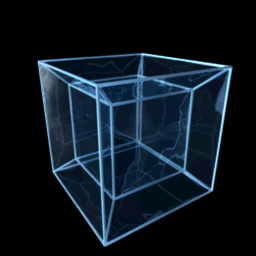"I have called this system of higher logic TERTIUM ORGANUM because for us it is the third canon - third instrument - of thought after those of Aristotle and Bacon. The first was Organon, the second, Novum Organum. But the third existed earlier than the first."
P. D. Ouspensky («TERTIUM ORGANUM»).
FOUR-DIMENSIONAL space, if we try to imagine it to ourselves, will be the infinite repetition of our space, of our infinite three-dimensional sphere, as a line is the infinite repetition of a point.
Many things that have been said before will become much clearer to us when we dwell on the fact that the fourth dimension must be sought for in time.
It will become clear what is meant by the fact that it is possible to regard a four-dimensional body as the tracing of the movement in space of a three-dimensional body in a direction not confined within that space. Now the direction not confined in three-dimensional space in which any three-dimentional body moves - this is the direction of time. Any three-dimensional body, existing, is at the same time moving in time and leaves as a tracing of its movement the temporal, or four-dimensional body. We never see or feel this body, because of the limitations ou our receptive apparatus, but we see the section of it only, which section we call the three-dimensional body. Therefore we are in error in thinking that the three-dimensional body is in itself something real. It is the projection of the four-dimensional body - its picture - the image of it on our plane.
The four-dimensional body is the infinite number of three-dimensional bodies. That is, the four-dimensional body is the infinite number of moments of existence of the three-dimensional one - its states and positions. The three-dimensional body which we see appears as a single figure - one of a series of pictures on a cinematographic film as it were.
Four-dimensional space (time) is really the distance between the forms, states, and positions of one and the same body (and diferent bodies, i.e., those seeming different to us). It separates those states, forms, and positions each from the other, and it binds them also into some to us incomprehensible whole. This incomprehensible whole can be formed in time out of one physical body - and out of different bodies.
It is easier for us to imagine the temporal whole as related to one physical body.
If we consider the physical body of a man, we shall find in it besides its "matter" something, it is true, changing, but undoubtedly one and the same from birth until death.
The something is the Linga-Sharîra of Hindu philosophy, i.e., the form on which our physical body is moulded. (H. P. Blavatsky: The Secret Doctrine.) Eastern philosophy regards the physical body as something impermanent which is in a condition of perpetual interchange with its surroundings. The particles come and go. After one second the body is already not absolutely the same as it was one second before. Today it is in a considerable degree not that which it was yesterday. After seven years it is a quite different body. But despite all this, something always persists from birth to death, changing its aspect a little, but remaining the same. This is the Linga-Sharîra.
The Linga-Sharîra is the form, the image: it changes, but remains the same. That image of a man which we are able to represent to ourselves is not the Linga-Sharîra. But if we try to represent to ourselves mentally the image of a man from birth to death, with all the particularities and traits of childhood, manhood and senility, as if extended in time, then it will be the Linga-Sharîra.
Form pertains to all things. We say that everything consists of matter and form. Under the category of "matter", as already stated, the cause of a lengthy series of mixed sensations is predicted, but matter without form is not comprehensible to us; we cannot even think of matter without form. But we can think and imagine form without matter.
 |
Tashilhunpo Monastery, Shigatse, the place that Blavatsky claimed held the Senzar texts she translated.
|
The thing, i.e., the union of form and matter, is never constant; it always changes in the course of time. This idea afforded Newton the possibility of bulding his theory of fluents and fluxions.
Newton came to the conclusion that constant quantities do not exist in nature. Variables do exist - flowing, fluents only. The velocities with which different fluents change were called by Newton fluxions.
From the standpoint of this theory all things known to us - men, plants, animals, planets - are fluents, and they differ by the magnitude of their fluxions. But the thing, changing continuously in time, sometimes very much, and quickly, as in the case of a living body for example, still remains one and the same. The body of a man in youth, and the body of a man in senility - these are one and the same, though we know that in the old body there is not one atom left that was in the young one. The matter changes, but sometimes remains one under all changes, this something is the Linga-Sharîra. Newton's theory is valid for the three-dimensional world existing in time. In this world there is nothing constant. All is variable because every consecutive moment the thing is already not that which it was before. We never see the Linga-Sharîra, we see always its parts, and they appear to us variable. But if we observe more attentively we shall see that it is an illusion. Things of three dimensions are unreal and variable. They cannot be real because they do not exist in reality, just as the imaginary sections of a solid do not exist. Four-dimensional bodies alone are real.
In one of the lectures contained in the book, a Pluralistic Universe, Prof. James calls attention to Prof. Bergson's remark that science studies always only the t of the universe, i.e., not the universe in its entirety, but the moment, the "temporal section" of the universe.
The properties of four-dimension space will become clearer to us if we compare in detail three-dimensional space with the surface, and discover the differences existing between them.
Hinton, in his book, A New Era of Thought, examines these differences very attentively. He represents to himself, on a plane, two equal rectangular triangles, cut out of paper, the right angles of which are placed in opposite directions. These triangles will be equal, but for some reason quite different. The right angle of one is directed to the right, that of the other to the left. If anyone wants to make them quite similar, it is possible to do so only with the help of three-dimensional space. That is, it is necessary to take one triangle, turn it over, and put it back on the plane. Then they will be two equal, and exactly similar triangles. But in order to effect this, it was necessary to take one triangle from the plane into three-dimensional space, and turn it over in that space. If the triangle is left on the plane, then it will never be possible to make it identical with the other, keeping the same relation of angles of the one to those of the other. If the triangle is merely rotated in the plane this similarity will never be established. In our world there are figures quite analogous to these two triangles.
We know certain shapes which are equal the one to the other, which are exactly similar, and yet which we cannot make fit into the same portion of space, either practically or by imagination.
If we look at our two hands we see this clearly, though the two hands represent a complex case of a symmetrical similarity. Now there is one way in which the right hand and the left hand may practically be brought into likeness. If we take the right hand glove and the left hand glove, they will not fit any more than the right hand will coincide with the left hand; but if we turn one glove inside out, then it will fit. Now suppose the same thing done with the solid hand as is done with the glove when it is turned inside out, we must suppose it, so to speak, pulled through itself… If such an operation were possible, the right hand would be turned into as exact model of the left hand [C. H. Hinton, "A New Era of Thought," p. 44].
But such an operation would be possible in the higher dimensional space only, just as the overturning of the triangle is possible only in a space relatively higher than the plane. Even granting the existence of four-dimensional space, it is possible that the turning of the hand inside out and pulling of it through itself is a practical impossibility on account of causes independent of geometrical conditions. But this does not diminish its value as an example. Things like the turning of the hand inside out are possible theoretically in four-dimensional space because in this space different, and even distant points of our space and time touch, or have the possibility of contact. All points of a sheet of paper lying on a table are separated one from another, but by taking the sheet from the table it is possible to fold it in such a way as to bring together any given points. If on one corner is written St. Petersburg, and on other Madras, nothing prevents the putting together of these corners. And if on the third corner is written the year 1812, and on the fourth 1912, these corners can touch each other too. If on one corner the year is written in red ink, and the ink has not yet dried, then the figures may imprint themselves on the other corner. And if afterwards the sheet is straightened out and laid on the table, it will be perfectly incomprehensible, to a man who has not followed the operation, how the figure from one corner could transfer itself to another corner. For such a man the possibility of the contact of remote points of the sheet will be incomprehensible, and it will remain incomprehensible so long as he thinks of the sheet in two-dimensional space only. The moment he imagines the sheet in three-dimensional space this possibility will become real and obvious to him.
 |
See here
|
In considering the relation of the fourth dimension to the three known to us, we must conclude that our geometry is obviously insufficient for the investigation of higher space.
As before stated, a four-dimensional body is as incommensurable with a three-dimensional one as a year is incommensurable with St. Petersburg.
It is quite clear why this is so. The four-dimensional body consists of an infinitely great number of three-dimensional bodies; accordingly, there cannot be a common measure for them. The three-dimensional body, in comparison with the four-dimensional one, is equivalent to the point in comparison with the line.
And just as the point is incommensurable with the line, so is the line incommensurable with the surface; as the surface is incommensurable with the solid body, so is the three-dimensional body incommensurable with the four-dimensional one.
It is clear also why the geometry of three dimensions is insufficient for the definition of the position of the region of the fourth dimension in relation to three-dimensional space.
Just as in the geometry of one dimension, that is, upon the line, it is impossible to define the position of the surface, the side of which constitutes the given line; just as in the geometry of two dimentions, i.e., upon the surface, it is impossible to define the position of the solid, the side of which constitutes the given surface, so in the geometry of three dimensions, in three-dimensional space, it is impossible to define a four-dimensional space. Briefly speaking, as planimetry is insufficient for the investigation of the problems of stereometry, so is stereometry insufficient for four-dimensional space.
As a conclusion from all of the above we may repeat that every point of our space is the sectiom of a line in higher space, or as B. Riemann expressed it: the material atom is the entrance of the fourth dimension into three-dimensional space.
For a nearer approach to the problem of higher dimensions and of higher space it is necessary first of all to understand the constitution and properties of the higher dimensional region in comparison with the region of three dimensions. Then only will appear the possibility of a more exact investigation of this region, and a classification of the laws governing it.
What is it that it is necessary to understand?
It seems to me that first of all it is necessary to understand that we are considering not two regions spatially different, and not two regions of which one (again spatially, "geometrically") constitutes a part of the other, but two methods of receptivity of one and the same unique world of a space which is unique.
Furthermore it is necessary to understand that all objects known to us exist not only in those categories in which they are perceveid by us, but in an infinite number of others in which we do not and cannot sense them. And we must learn first to think things in other categories, and then so far as we are able, to imagine them therein. Only after doing this can we possibly develop the faculty to apprehend them in higher space - and to sense "higher" space itself.
Or perhaps the first necessity is the direct perception of everything in the outsider world which does not fit into the frame of three dimensions, which exist independently of the categories of time and space - everything that for this reason we are accustomed to consider as non-existent. If variability is an indication of the three-dimensional world, then let us search for the constant and thereby approach to an understanding of the four-dimensional world.
We have become accustomed to count as really existing only that which is measurable in terms of length, breadth and height; but as has been shown it is necessary to expand the limits of the really existing. Mensurability is to rough an indication of existence, because mensurability itself is too conditioned a conception. We may say that for any approach to the exact investigation of the higher dimensional region the certainty obtained by the immediate sensation is probably indispensable; that much that is immeasurable exists just as really as, and even more really than, much that is measurable. (in TERTIUM ORGANUM. A Key to the Enigmas of the World, Routledge & Kegan Paul, 1973, pp. 45-50).
 |
| See here |







































Nenhum comentário:
Postar um comentário